
Multipath Reception
Experiments with mobile communication were done at VHF frequencies already in the 1920s. Results of these tests (at about 50 MHz) revealed a very hostile
propagation environment, particularly in urban centers.
Signal quality varied from "excellent" to "no signal". Moving the vehicle over a few meters resulted in dramatic changes of the received field strength.
The mobile or indoor radio channel
is characterized by 'multipath
reception':
The signal offered to the receiver contains not only a
direct line-of-sight
radio wave, but also a large number of reflected
radio waves.

These reflected waves interfere with the direct wave,
which causes significant degradation of the performance of the network.
A wireless network has to be designed in such way that the adverse
effect of these reflections is minimized.
 Although channel fading is experienced as an unpredictable, stochastic
phenomenon, powerful models have been developed that can
accurately predict system performance.
Although channel fading is experienced as an unpredictable, stochastic
phenomenon, powerful models have been developed that can
accurately predict system performance.
Most conventional modulation techniques are sensitive to intersymbol
interference unless the channel symbol rate is small compared to the
delay spread of the channel.
Nonetheless, a signal received at a frequency
and location where reflected waves cancel each other,
is heavily attenuated and may thus suffer large
bit error rates.
Models for multipath reception
Narrowband Rayleigh, or
Rician models mostly
address the channel behaviour at one frequency only.
Dispersion is modelled by the
delay spread.
The effect of multipath reception
- for a fast moving user: rapid fluctuations of the signal amplitude and phase
- for a wideband (digital) signal: dispersion and intersymbol interference
- for an analog television signal: "ghost" images (shifted slightly to the right)
- for a multicarrier signal: different attenuation at different (sub-)carriers and at different locations
- for a stationary user of a narrowband system: good reception at some locations and frequencies; poor reception at other locations and frequencies.
- for a satellite positioning system: strong delayed reflections
may cause a severe miscalculation
of the distance between user and satellite. This can result in a wrong "fix".








 Although channel fading is experienced as an unpredictable, stochastic
phenomenon, powerful models have been developed that can
accurately predict system performance.
Although channel fading is experienced as an unpredictable, stochastic
phenomenon, powerful models have been developed that can
accurately predict system performance.